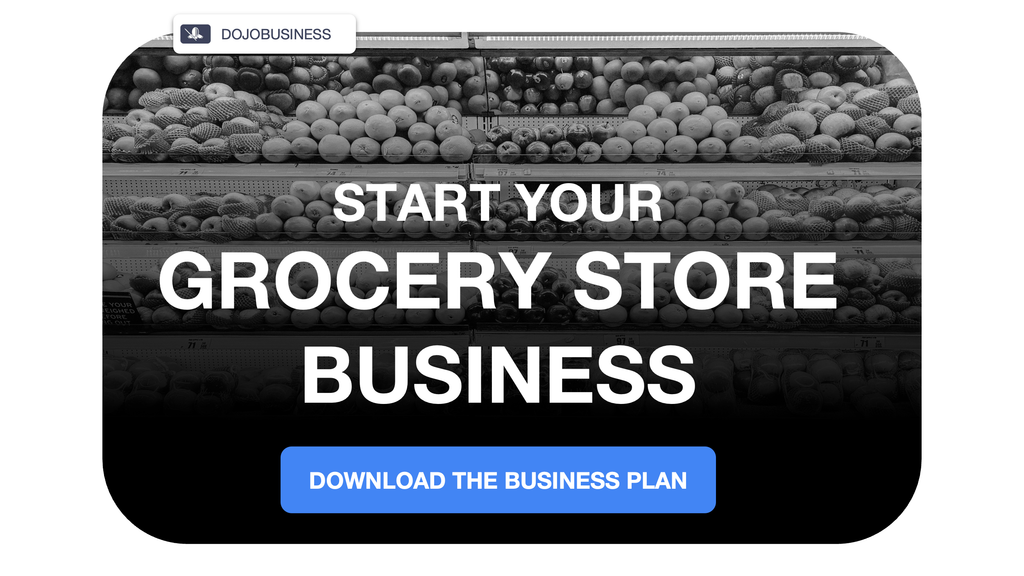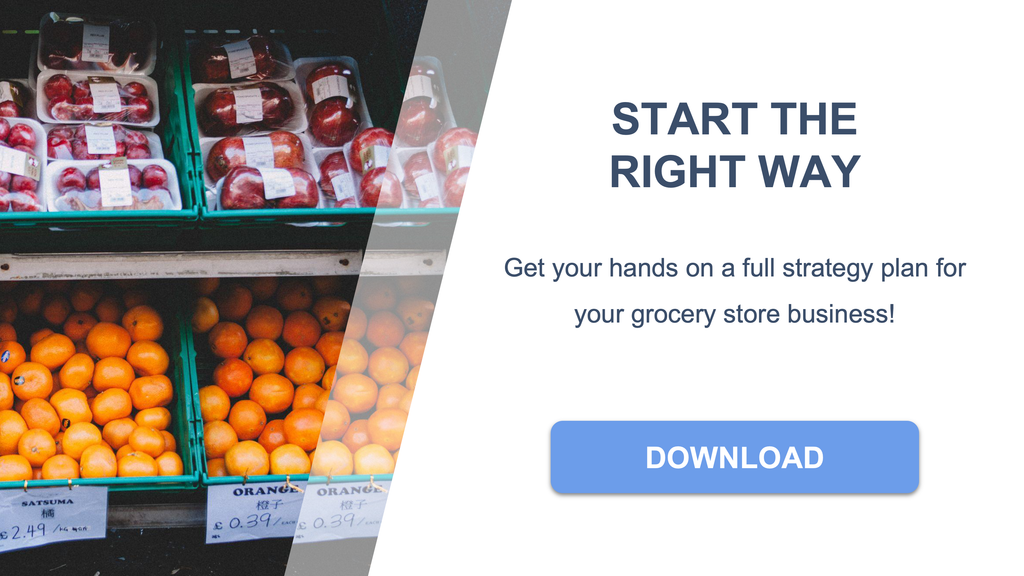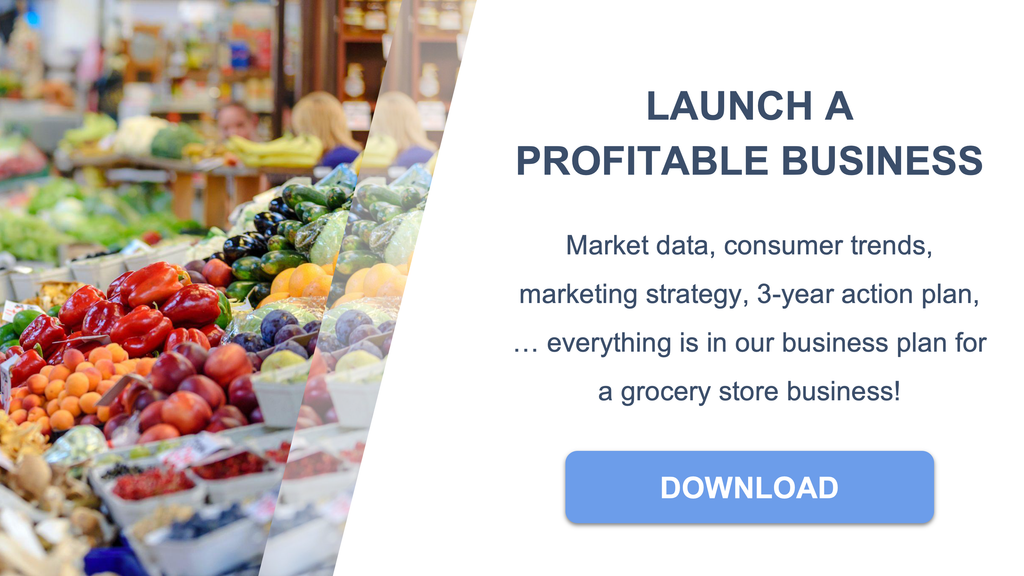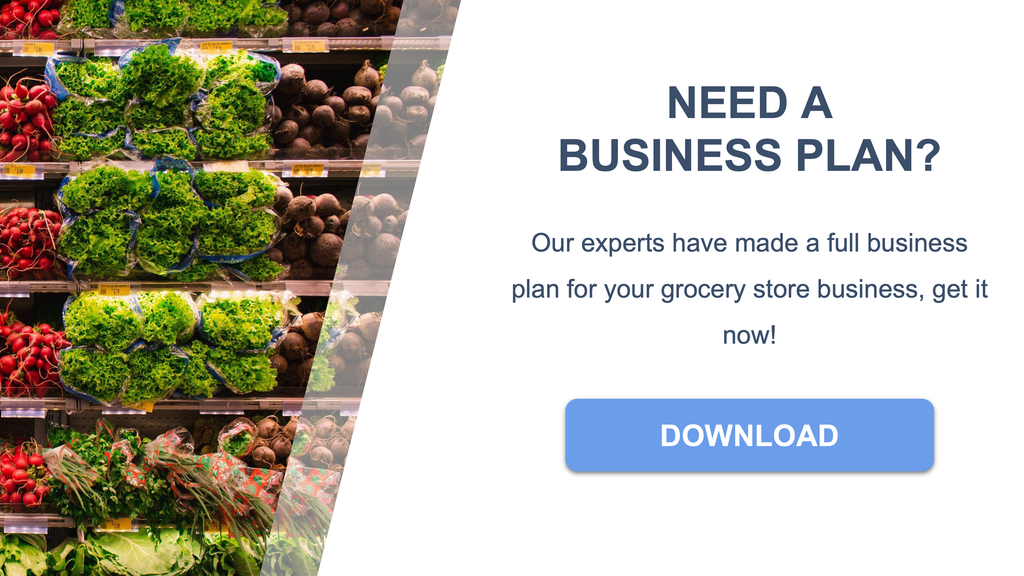This article was written by our expert who is surveying the industry and constantly updating the business plan for a grocery store.

Setting up a grocery store requires strategic investment across multiple equipment categories to ensure efficient operations and profitability.
Each category—from refrigeration to checkout systems—has specific cost ranges and budgeting considerations that directly impact your startup expenses. Understanding these upfront costs helps you allocate funds wisely and avoid expensive mistakes during the launch phase.
If you want to dig deeper and learn more, you can download our business plan for a grocery store. Also, before launching, get all the profit, revenue, and cost breakdowns you need for complete clarity with our grocery store financial forecast.
Opening a grocery store demands careful equipment budgeting across eleven core categories, with total initial equipment costs typically ranging from $50,000 to $120,000 for a mid-sized location.
The table below provides a comprehensive breakdown of each equipment category, typical cost ranges, and critical budgeting considerations to help you plan your grocery store investment effectively.
| Equipment Category | Typical Cost Range | Key Budgeting Notes |
|---|---|---|
| Refrigeration Equipment | $18,000–$25,000 | Total budget for a mid-sized grocery store includes walk-in coolers, freezers, display cases, and installation. Individual units range from $2,000 to $10,000 depending on size and efficiency ratings. |
| Shelving & Racking Systems | $5,000–$15,000 | Gondola shelving, end caps, and wall units vary based on layout quality and store configuration. Metal racking systems and custom installations affect final pricing. |
| POS Systems (per lane) | $2,000–$6,000 | Complete hardware and software bundle including terminals, scanners, receipt printers, cash drawers, licensing, and cloud-based options. Budget additional funds for installation and multi-lane expansion. |
| Security Equipment | $2,000–$6,000 | Basic camera and alarm installation for small stores. Coverage area, system scalability, resolution quality, night-vision capabilities, storage capacity, and remote monitoring features drive costs higher for larger stores. |
| Back-Office Equipment | $2,000–$5,000 | Computers, printers, network equipment, and office furniture scaled to administrative needs and store size requirements. |
| Kitchen & Food Prep (Deli) | $5,000–$20,000 | Deli slicers, meat grinders, scales, food processors, prep tables, and warming units. Menu scope and deli section size significantly impact equipment selection and costs. |
| Store Lighting | $3,000–$8,000 | Energy-efficient LED fixtures ($50–$300 per unit) balance efficiency with product visibility. High CRI LEDs recommended for accurate product display. Consider government rebates for energy-saving installations. |
| Cleaning & Maintenance Equipment | $2,000–$5,000 | Commercial-grade vacuums, floor scrubbers, janitorial carts, and cleaning supplies essential for food safety compliance. Deli sections require specialized sanitation equipment. |
| Checkout Counters (per lane) | $2,000–$6,000 | Integrated conveyor belts, dividers, and bagging stations. Costs vary with customization options, material quality, and number of checkout lanes required. |
| Signage (Total) | $3,000–$8,000 | Branded exterior signage, aisle markers, promotional signs, and wayfinding systems. Digital or illuminated signage commands premium pricing. |
| Annual Maintenance Budget | 10%–15% of initial costs | Industry standard allocation for repairs, replacements, and preventive maintenance. Average U.S. grocery stores spend approximately $100,000 annually on all equipment maintenance, with one-third dedicated to refrigeration systems. |

What are the core categories of equipment needed for setting up a grocery store?
A grocery store requires eleven distinct equipment categories to operate efficiently and serve customers effectively.
The refrigeration category includes walk-in coolers, walk-in freezers, and refrigerated display units that maintain product freshness and food safety standards. These units are essential for perishable goods including dairy, meat, produce, and frozen foods.
Shelving and racking systems form the backbone of your product display infrastructure, encompassing gondola shelving, end caps, and wall-mounted units. Point-of-sale systems combine hardware terminals, barcode scanners, receipt printers, and software to process customer transactions and manage inventory data.
Security equipment protects your investment through surveillance cameras, alarm systems, and access control mechanisms. Back-office equipment supports administrative functions with computers, printers, network infrastructure, and office furniture for management tasks.
Kitchen and food preparation equipment becomes necessary if you plan to offer fresh-prepared items, deli products, or bakery goods. Store lighting fixtures ensure adequate visibility for both customers and staff while maintaining energy efficiency. Cleaning and maintenance equipment maintains hygiene standards required for food retail operations.
Checkout counters, conveyor belts, and bagging stations complete the customer checkout experience. Interior and exterior signage guides customers, promotes products, and establishes your brand identity in the marketplace.
How much should be allocated for refrigeration equipment, including freezers and display units?
Budget between $18,000 and $25,000 for total refrigeration equipment in a mid-sized grocery store, covering all coolers, freezers, and display cases with installation.
Individual commercial refrigeration units typically cost between $2,000 and $10,000 per unit depending on size, capacity, and energy efficiency ratings. Walk-in coolers and freezers occupy the higher end of this range due to their larger footprint and specialized construction requirements.
Display refrigerators for beverages, dairy products, and grab-and-go items generally fall in the $3,000 to $6,000 range per unit. Energy-efficient models with superior insulation and LED lighting cost more upfront but reduce operating expenses through lower electricity consumption.
Installation costs add 10% to 20% to equipment prices, covering electrical work, refrigerant lines, and professional setup. Your refrigeration budget should also account for backup systems or redundancy to prevent product loss during equipment failures.
You'll find detailed market insights in our grocery store business plan, updated every quarter.
What is the typical cost range for shelving and racking systems that will maximize product display and storage?
Shelving and racking systems for a small-to-mid-sized grocery store typically cost between $5,000 and $15,000, varying with layout complexity and quality specifications.
Standard gondola shelving units—the double-sided fixtures commonly seen in grocery aisles—range from $150 to $500 per section depending on height, depth, and weight capacity. A typical grocery store requires 20 to 40 gondola sections to create adequate aisle space for product categories.
End cap displays cost between $200 and $600 each and serve as premium promotional space for high-margin or featured products. Wall shelving units run $100 to $300 per linear foot and maximize perimeter space for additional product storage.
Metal racking systems for backroom storage cost $75 to $200 per unit and provide essential overflow storage for inventory management. Bulk orders generally reduce per-unit costs by 15% to 25%, while custom configurations or specialty finishes increase expenses.
Layout design significantly impacts total shelving costs—optimized floor plans reduce the number of units needed while improving customer flow and product visibility throughout your grocery store.
How should the store budget for point-of-sale (POS) systems and related technology, including hardware and software?
Allocate $2,000 to $6,000 per checkout lane for complete POS systems including hardware, software, licensing, and installation in your grocery store.
POS hardware components include touch-screen terminals ($500–$1,500), barcode scanners ($100–$400), receipt printers ($200–$500), cash drawers ($100–$300), and customer-facing displays ($200–$600). Integrated payment processing terminals add another $300 to $800 per lane for credit card, debit card, and contactless payment capabilities.
Software licensing varies between one-time purchases ($1,000–$3,000 per system) and monthly subscriptions ($50–$200 per month per terminal). Cloud-based POS systems offer lower upfront costs but require ongoing subscription payments, while on-premise solutions demand higher initial investment with minimal recurring fees.
Budget an additional 15% to 25% of hardware costs for professional installation, system configuration, staff training, and initial technical support. Multi-lane stores benefit from volume discounts—expect to save 10% to 20% when purchasing three or more complete POS systems simultaneously.
Plan for future expansion by selecting scalable systems that accommodate additional checkout lanes, self-checkout stations, or mobile payment options as your grocery store grows.
What are the key factors to consider when budgeting for security equipment, such as cameras and alarm systems?
Security equipment budgets for grocery stores range from $2,000 to $6,000 for basic installations in smaller stores, with costs increasing substantially for larger facilities requiring comprehensive coverage.
| Security Factor | Budget Impact | Specific Considerations for Grocery Stores |
|---|---|---|
| Coverage Area | $300–$800 per camera | Larger grocery stores require more cameras to monitor entrances, exits, aisles, checkout lanes, stockrooms, and loading docks. Calculate one camera per 800–1,200 square feet of retail space for adequate coverage. |
| Camera Resolution | $150–$600 per unit | High-definition cameras (1080p or 4K) provide clearer footage for identifying shoplifters and resolving transaction disputes. Budget premium for cameras in checkout areas and high-theft product zones. |
| Night Vision Capability | $200–$500 per camera | Essential for 24-hour grocery stores or monitoring after closing hours. Infrared cameras capture clear footage in low-light conditions including stockrooms and parking areas. |
| Storage Capacity | $500–$2,000 | Digital video recorders (DVR) or network video recorders (NVR) store footage for 30–90 days as required by insurance policies. Cloud storage options cost $20–$100 monthly per camera. |
| Remote Monitoring | $0–$50 monthly | Mobile apps and web interfaces allow owners to view live feeds from any location. Professional monitoring services cost $30–$60 monthly and provide 24/7 surveillance with emergency response capabilities. |
| System Integration | $500–$2,000 | Advanced systems integrate cameras with POS terminals to detect scanning fraud, connect alarm systems with automated police notification, and link access control to employee time tracking. |
| System Scalability | 10%–20% premium | Expandable systems accommodate future camera additions, upgraded recording equipment, and integration with other security technologies as your grocery store grows or relocates. |
How should the store budget for back-office equipment like computers, printers, and office furniture?
Allocate $2,000 to $5,000 for back-office equipment in your grocery store, adjusting based on administrative needs and staff size.
Computer systems for management, accounting, and inventory control cost between $600 and $1,500 per workstation including desktop or laptop hardware, monitors, keyboards, and mice. Budget for at least two workstations—one for the office manager and another for scheduling, payroll, and administrative tasks.
Commercial-grade printers and multifunction devices range from $300 to $1,000 depending on print volume, scanning capabilities, and network connectivity requirements. Network equipment including routers, switches, and Wi-Fi access points costs $200 to $800 for small grocery stores.
Office furniture encompasses desks ($200–$800), ergonomic chairs ($150–$500), filing cabinets ($100–$400), and storage solutions ($150–$600). Used or refurbished office furniture reduces costs by 40% to 60% while still providing functional workspace for administrative staff.
This is one of the strategies explained in our grocery store business plan.
What are the costs associated with essential kitchen and food preparation equipment if the store offers fresh products or a deli?
Kitchen and food preparation equipment for grocery store delis costs between $5,000 and $20,000 depending on menu complexity and service scope.
Deli slicers represent a major investment at $800 to $3,000 per unit depending on blade size, motor power, and safety features. Commercial meat grinders cost $500 to $2,500 and enable fresh ground meat preparation for customers seeking quality and customization.
Digital scales for weighing deli products range from $100 to $500 per unit—budget for multiple scales at service counters and prep areas. Food processors ($200–$1,000) and commercial mixers ($400–$2,000) support salad preparation, sandwich spreads, and other prepared food offerings.
Stainless steel prep tables cost $300 to $1,200 each and provide essential food-safe work surfaces for cutting, assembling, and packaging. Hot food holding equipment including warming units, rotisserie ovens, and heated display cases ranges from $500 to $3,000 per unit.
Refrigerated prep tables ($1,500–$4,000) keep ingredients at safe temperatures during preparation, while three-compartment sinks ($400–$1,500) meet health department requirements for washing, rinsing, and sanitizing utensils and equipment in your grocery store deli.
What is the typical budget allocation for store lighting, ensuring energy efficiency and adequate product visibility?
Budget $3,000 to $8,000 for complete lighting installation in a mid-sized grocery store, prioritizing energy-efficient LED fixtures that balance operational costs with product presentation.
Individual LED fixtures range from $50 to $300 per unit depending on brightness output, fixture type, and quality specifications. A typical grocery store requires 30 to 80 fixtures to achieve recommended illumination levels of 50 to 75 foot-candles throughout the retail space.
High Color Rendering Index (CRI) LED lights—rated 90 or above—cost 20% to 30% more than standard fixtures but accurately display product colors, particularly crucial for fresh produce, meat, and bakery items. Track lighting for specialty displays adds $100 to $400 per section and highlights premium or promotional products.
Government rebate programs frequently offset 25% to 50% of LED installation costs, significantly reducing your effective investment. Calculate annual energy savings of $1,500 to $4,000 when replacing traditional fluorescent or incandescent fixtures with LED equivalents.
Motion sensors in stockrooms and employee areas ($30–$100 per sensor) further reduce electricity consumption by automatically controlling lights based on occupancy in your grocery store.
How should the store allocate funds for cleaning and maintenance equipment to maintain hygiene and safety standards?
Allocate $2,000 to $5,000 for commercial-grade cleaning and maintenance equipment to meet food safety regulations and maintain customer-appealing conditions in your grocery store.
Commercial wet-dry vacuums cost $300 to $800 and handle both routine cleaning and emergency spills across various floor surfaces. Automatic floor scrubbers range from $1,500 to $4,000 for walk-behind models and dramatically reduce labor time compared to manual mopping in larger stores.
Janitorial carts ($150–$400) organize cleaning supplies and provide mobile workstations for staff. Pressure washers ($200–$600) maintain loading docks, outdoor areas, and equipment sanitation requirements.
Initial cleaning supply inventory costs $300 to $800 and includes sanitizers, degreasers, floor cleaners, and specialty products for different surface types. Grocery stores with deli or food preparation areas require additional specialized sanitation equipment including steam cleaners ($400–$1,200) and sanitizing stations ($200–$600).
Budget ongoing monthly costs of $200 to $500 for cleaning supply replenishment to maintain consistent sanitation standards throughout your grocery store operations.
What are the average costs for checkout counters, conveyor belts, and other checkout-related hardware?
Checkout counters with integrated conveyor belts, dividers, and bagging stations cost $2,000 to $6,000 per lane in grocery stores.
Basic checkout counters without conveyors start at $1,200 to $2,500 per lane and provide functional checkout space for smaller stores or express lanes. Motorized conveyor belt systems add $800 to $2,000 per lane depending on length, durability, and speed control features.
Customer dividers cost $50 to $150 per set and separate purchases during high-volume periods. Bagging carousels or dual-sided bag holders ($100–$400) improve checkout efficiency by organizing filled bags and maximizing counter space.
Custom checkout counter configurations increase costs by 25% to 50% but optimize workflow for specific store layouts and customer traffic patterns. Material selection impacts pricing—laminate counters represent the budget option, while stainless steel or solid surface materials cost 40% to 80% more but offer superior durability and easier sanitation.
The number of checkout lanes directly scales total investment—a three-lane checkout area requires $6,000 to $18,000 for complete counter systems in your grocery store.
Get expert guidance and actionable steps inside our grocery store business plan.
How should the store factor in the costs for signage, both interior and exterior, including branding and promotions?
Budget $3,000 to $8,000 for comprehensive signage in your grocery store, covering exterior branding, interior wayfinding, and promotional displays.
Exterior storefront signs range from $2,000 to $5,000 depending on size, illumination, materials, and local permit requirements. Channel letter signs with LED illumination cost more than flat panel signs but provide superior visibility and professional branding impact.
Interior aisle markers and department signs cost $30 to $150 per sign, with grocery stores typically requiring 25 to 50 signs for clear navigation. Hanging signs suspended from ceiling tracks cost more than wall-mounted options but improve visibility from multiple angles.
Promotional sign holders ($15–$60 each) display pricing, sales, and product information throughout the store. Digital signage displays ($500–$2,000 per screen) offer dynamic content rotation for promotions, recipes, and community announcements.
Window decals, floor graphics, and checkout lane signage add another $500 to $1,500 to your total signage budget. Professional graphic design services cost $500 to $2,000 for cohesive branding across all signage elements in your grocery store.
What are the ongoing maintenance costs for the essential equipment, and how should these be planned for in the budget?
Plan to allocate 10% to 15% of your initial equipment investment annually for ongoing maintenance, repairs, and replacements in your grocery store.
| Equipment Category | Annual Maintenance Rate | Maintenance Planning Details |
|---|---|---|
| Refrigeration Systems | 15%–20% of equipment value | Refrigeration represents the highest maintenance expense in grocery stores, consuming approximately one-third of total annual equipment maintenance budgets (roughly $33,000 of a typical $100,000 annual maintenance budget). Schedule quarterly preventive maintenance including coil cleaning, refrigerant level checks, door seal inspections, and compressor servicing to prevent costly breakdowns. |
| POS Systems | 8%–12% of equipment value | Software updates, hardware repairs, receipt paper, printer maintenance, and technical support contracts typically cost $160 to $720 annually per terminal. Cloud-based systems include updates in monthly fees, while on-premise systems require separate update purchases and IT support. |
| Shelving & Fixtures | 3%–5% of equipment value | Minimal maintenance costs including shelf replacement, paint touch-ups, and hardware tightening. Budget $150 to $750 annually for a typical grocery store to repair damaged sections and maintain professional appearance. |
| Security Systems | 10%–15% of equipment value | Camera cleaning, hard drive replacement, software updates, and alarm system testing cost $200 to $900 annually. Professional monitoring services add $360 to $720 yearly. Replace DVR/NVR systems every 5–7 years and individual cameras every 7–10 years. |
| Kitchen Equipment (Deli) | 12%–18% of equipment value | Blade sharpening, motor servicing, seal replacement, and deep cleaning for deli equipment costs $600 to $3,600 annually depending on usage intensity. Health department compliance requires documented maintenance schedules for food-contact equipment. |
| Lighting Systems | 5%–8% of equipment value | LED fixture replacement, ballast repairs, and bulb changes cost $150 to $640 annually. LED fixtures last 50,000–100,000 hours (approximately 10–15 years), dramatically reducing replacement frequency compared to traditional lighting. |
| Cleaning Equipment | 10%–15% of equipment value | Floor scrubber maintenance, vacuum repairs, and replacement parts cost $200 to $750 annually. Commercial equipment requires professional servicing every 6–12 months to maintain warranty coverage and operational efficiency. |
| Emergency Replacement Fund | 5% of total equipment value | Reserve $2,500 to $6,000 annually for unexpected equipment failures requiring immediate replacement. Major refrigeration breakdowns represent the greatest financial risk—maintain relationships with 24-hour service providers to minimize product loss during emergencies in your grocery store. |
Conclusion
This article is for informational purposes only and should not be considered financial advice. Readers are encouraged to consult with a qualified professional before making any investment decisions. We accept no liability for any actions taken based on the information provided.
Budgeting effectively for grocery store equipment requires understanding the specific cost ranges and maintenance requirements for each category.
By allocating funds strategically across refrigeration, shelving, POS systems, security, and other essential equipment, you position your grocery store for operational success while controlling startup costs and planning for ongoing maintenance expenses.
Sources
- Dojo Business - Grocery Store Equipment List
- Chef's Deal - Grocery Store Equipment List
- Bravo Kitchen Equipment - Supermarket Equipment Guide
- Chilltech Group - Supermarket Setup Guide
- Dojo Business - Grocery Store Equipment Budget
- Shopfitting Manufacturer - Supermarket Racks Guide
- Alto-Shaam - Convenience Store Equipment Considerations
- National Renewable Energy Laboratory - Energy Efficiency Guide
- Kaivac - Grocery Cooler Maintenance Costs
- Chef's Deal - Commercial Refrigeration Costs






